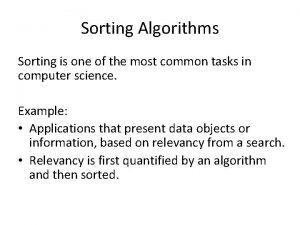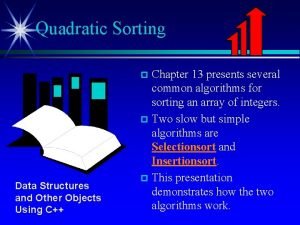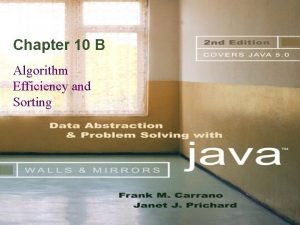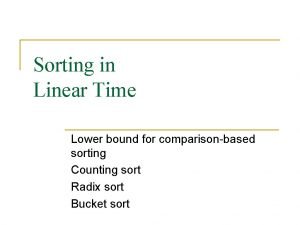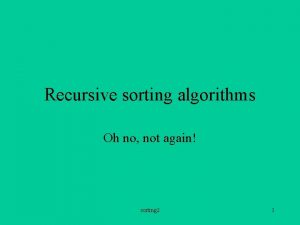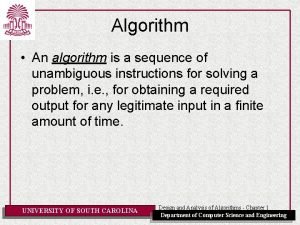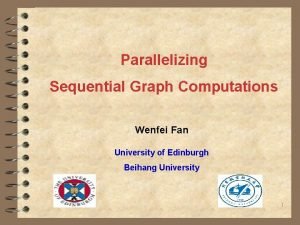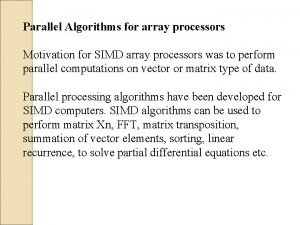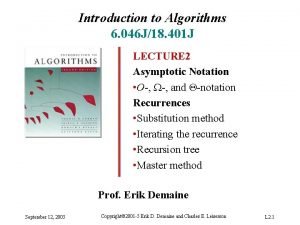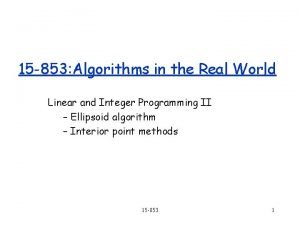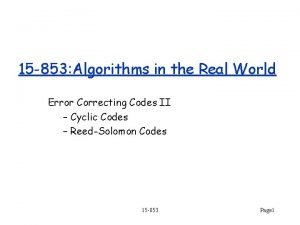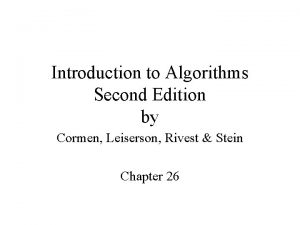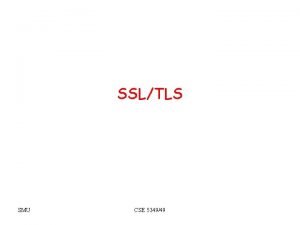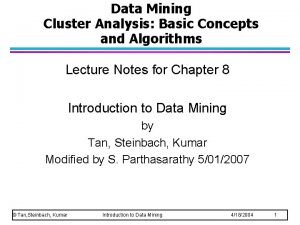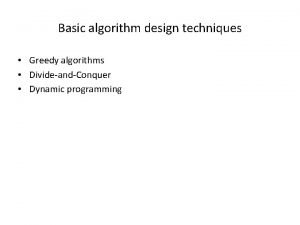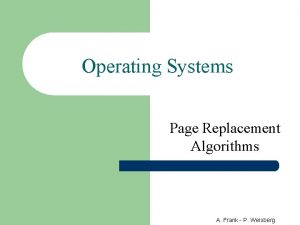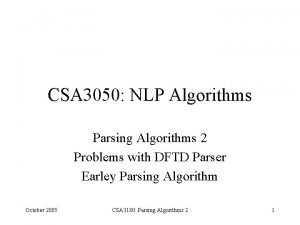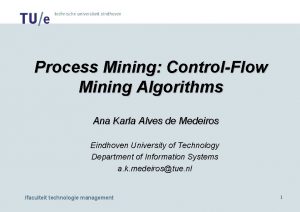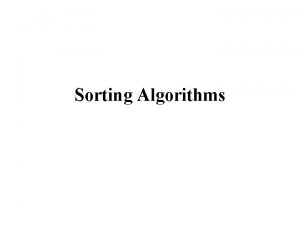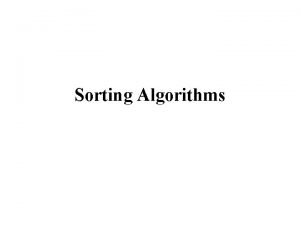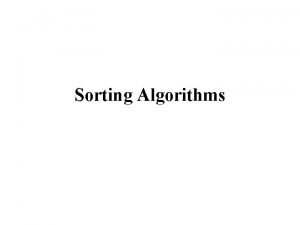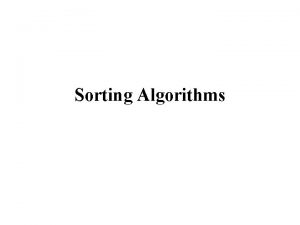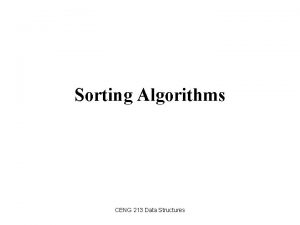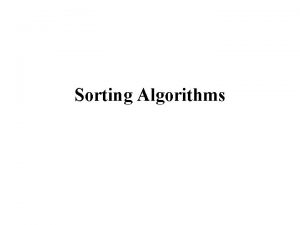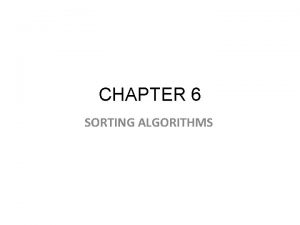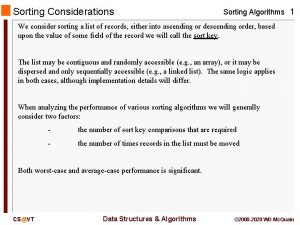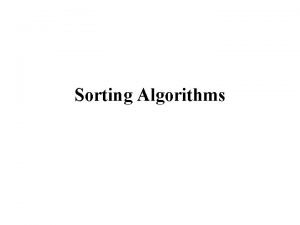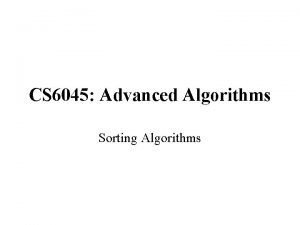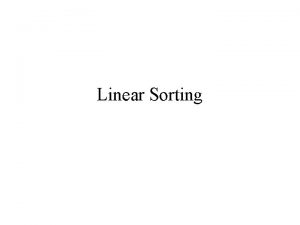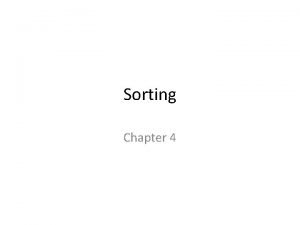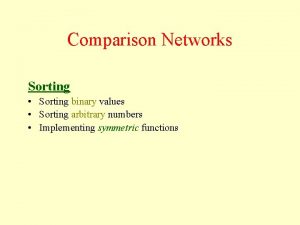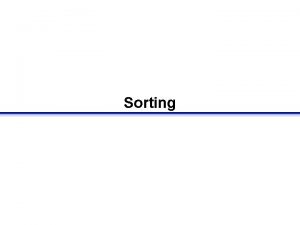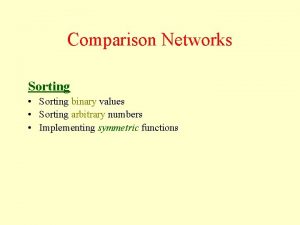Sorting Algorithms Topic Overview Issues in Sorting on





























































![Bucket and Sample Sort • In Bucket sort, the range [a, b] of input Bucket and Sample Sort • In Bucket sort, the range [a, b] of input](https://slidetodoc.com/presentation_image_h/057156487c9caf492af722b3dd0a3348/image-62.jpg)






- Slides: 68

Sorting Algorithms

Topic Overview • Issues in Sorting on Parallel Computers • Sorting Networks • Bubble Sort and its Variants • Quicksort • Bucket and Sample Sort • Other Sorting Algorithms

Sorting: Overview • One of the most commonly used and well-studied kernels. • Sorting can be comparison-based or noncomparison-based. • The fundamental operation of comparison-based sorting is compare-exchange. • The lower bound on any comparison-based sort of n numbers is Θ(nlog n) . • We focus here on comparison-based sorting algorithms.

Sorting: Basics What is a parallel sorted sequence? Where are the input and output lists stored? • We assume that the input and output lists are distributed. • The sorted list is partitioned with the property that each partitioned list is sorted and each element in processor Pi's list is less than that in Pj's list if i < j.

Sorting: Parallel Compare Exchange Operation A parallel compare-exchange operation. Processes Pi and Pj send their elements to each other. Process Pi keeps min{ai, aj}, and Pj keeps max{ai, aj}.

Sorting: Basics What is the parallel counterpart to a sequential comparator? • If each processor has one element, the compare exchange operation stores the smaller element at the processor with smaller id. This can be done in ts + tw time. • If we have more than one element per processor, we call this operation a compare split. Assume each of two processors have n/p elements. • After the compare-split operation, the smaller n/p elements are at processor Pi and the larger n/p elements at Pj, where i < j. • The time for a compare-split operation is (ts+ twn/p), assuming that the two partial lists were initially sorted.

Sorting: Parallel Compare Split Operation A compare-split operation. Each process sends its block of size n/p to the other process. Each process merges the received block with its own block and retains only the appropriate half of the merged block. In this example, process Pi retains the smaller elements and process Pi retains the larger elements.

Sorting Networks • Networks of comparators designed specifically for sorting. • A comparator is a device with two inputs x and y and two outputs x' and y'. For an increasing comparator, x' = min{x, y} and y' = min{x, y}; and vice-versa. • We denote an increasing comparator by and a decreasing comparator by Ө. • The speed of the network is proportional to its depth.

Sorting Networks: Comparators A schematic representation of comparators: (a) an increasing comparator, and (b) a decreasing comparator.

Sorting Networks A typical sorting network. Every sorting network is made up of a series of columns, and each column contains a number of comparators connected in parallel.

Sorting Networks: Bitonic Sort • A bitonic sorting network sorts n elements in Θ(log 2 n) time. • A bitonic sequence has two tones - increasing and decreasing, or vice versa. Any cyclic rotation of such networks is also considered bitonic. • 1, 2, 4, 7, 6, 0 is a bitonic sequence, because it first increases and then decreases. 8, 9, 2, 1, 0, 4 is another bitonic sequence, because it is a cyclic shift of 0, 4, 8, 9, 2, 1. • The kernel of the network is the rearrangement of a bitonic sequence into a sorted sequence.

Sorting Networks: Bitonic Sort • Let s = a 0, a 1, …, an-1 be a bitonic sequence such that a 0 ≤ a 1 ≤ ··· ≤ an/2 -1 and an/2 ≥ an/2+1 ≥ ··· ≥ an-1. • Consider the following subsequences of s: s 1 = min{a 0, an/2}, min{a 1, an/2+1}, …, min{an/2 -1, an-1} s 2 = max{a 0, an/2}, max{a 1, an/2+1}, …, max{an/2 -1, an-1} (1) • Note that s 1 and s 2 are both bitonic and each element of s 1 is less than every element in s 2. • We can apply the procedure recursively on s 1 and s 2 to get the sorted sequence.

Sorting Networks: Bitonic Sort Merging a 16 -element bitonic sequence through a series of log 16 bitonic splits.

Sorting Networks: Bitonic Sort • We can easily build a sorting network to implement this bitonic merge algorithm. • Such a network is called a bitonic merging network. • The network contains log n columns. Each column contains n/2 comparators and performs one step of the bitonic merge. • We denote a bitonic merging network with n inputs by BM[n]. • Replacing the comparators by Ө comparators results in a decreasing output sequence; such a network is denoted by ӨBM[n].

Sorting Networks: Bitonic Sort A bitonic merging network for n = 16. The input wires are numbered 0, 1, …, n - 1, and the binary representation of these numbers is shown. Each column of comparators is drawn separately; the entire figure represents a BM[16] bitonic merging network. The network takes a bitonic sequence and outputs it in sorted order.

Sorting Networks: Bitonic Sort How do we sort an unsorted sequence using a bitonic merge? • We must first build a single bitonic sequence from the given sequence. • A sequence of length 2 is a bitonic sequence. • A bitonic sequence of length 4 can be built by sorting the first two elements using BM[2] and next two, using ӨBM[2]. • This process can be repeated to generate larger bitonic sequences.

Sorting Networks: Bitonic Sort A schematic representation of a network that converts an input sequence into a bitonic sequence. In this example, BM[k] and ӨBM[k] denote bitonic merging networks of input size k that use and Ө comparators, respectively. The last merging network ( BM[16]) sorts the input. In this example, n = 16.

Sorting Networks: Bitonic Sort The comparator network that transforms an input sequence of 16 unordered numbers into a bitonic sequence.

Sorting Networks: Bitonic Sort • The depth of the network is Θ(log 2 n). • Each stage of the network contains n/2 comparators. A serial implementation of the network would have complexity Θ(nlog 2 n).

Mapping Bitonic Sort to Hypercubes • Consider the case of one item per processor. The question becomes one of how the wires in the bitonic network should be mapped to the hypercube interconnect. • Note from our earlier examples that the compare-exchange operation is performed between two wires only if their labels differ in exactly one bit! • This implies a direct mapping of wires to processors. All communication is nearest neighbor!

Mapping Bitonic Sort to Hypercubes Communication during the last stage of bitonic sort. Each wire is mapped to a hypercube process; each connection represents a compare-exchange between processes.

Mapping Bitonic Sort to Hypercubes Communication characteristics of bitonic sort on a hypercube. During each stage of the algorithm, processes communicate along the dimensions shown.

Mapping Bitonic Sort to Hypercubes Parallel formulation of bitonic sort on a hypercube with n = 2 d processes.

Mapping Bitonic Sort to Hypercubes • During each step of the algorithm, every process performs a compare-exchange operation (single nearest neighbor communication of one word). • Since each step takes Θ(1) time, the parallel time is Tp = Θ(log 2 n) (2) • This algorithm is cost optimal w. r. t. its serial counterpart, but not w. r. t. the best sorting algorithm.

Mapping Bitonic Sort to Meshes • The connectivity of a mesh is lower than that of a hypercube, so we must expect some overhead in this mapping. • Consider the row-major shuffled mapping of wires to processors.

Mapping Bitonic Sort to Meshes Different ways of mapping the input wires of the bitonic sorting network to a mesh of processes: (a) row-major mapping, (b) row-major snakelike mapping, and (c) rowmajor shuffled mapping.

Mapping Bitonic Sort to Meshes The last stage of the bitonic sort algorithm for n = 16 on a mesh, using the row-major shuffled mapping. During each step, process pairs compare-exchange their elements. Arrows indicate the pairs of processes that perform compare-exchange operations.

Mapping Bitonic Sort to Meshes • In the row-major shuffled mapping, wires that differ at the ith least-significant bit are mapped onto mesh processes that are 2 (i-1)/2 communication links away. • The total amount of communication performed by each process is . The total computation performed by each process is Θ(log 2 n). • The parallel runtime is: • This is not cost optimal.

Block of Elements Per Processor • Each process is assigned a block of n/p elements. • The first step is a local sort of the local block. • Each subsequent compare-exchange operation is replaced by a compare-split operation. • We can effectively view the bitonic network as having (1 + log p)(log p)/2 steps.

Block of Elements Per Processor: Hypercube • Initially the processes sort their n/p elements (using merge sort) in time Θ((n/p)log(n/p)) and then perform Θ(log 2 p) compare-split steps. • The parallel run time of this formulation is • Comparing to an optimal sort, the algorithm can efficiently use up to processes. • The isoefficiency function due to both communication and extra work is Θ(plog 2 p).

Block of Elements Per Processor: Mesh • The parallel runtime in this case is given by: • This formulation can efficiently use up to p = Θ(log 2 n) processes. • The isoefficiency function is

Performance of Parallel Bitonic Sort The performance of parallel formulations of bitonic sort for n elements on p processes.

Bubble Sort and its Variants The sequential bubble sort algorithm compares and exchanges adjacent elements in the sequence to be sorted: Sequential bubble sort algorithm.

Bubble Sort and its Variants • The complexity of bubble sort is Θ(n 2). • Bubble sort is difficult to parallelize since the algorithm has no concurrency. • A simple variant, though, uncovers the concurrency.

Odd-Even Transposition Sequential odd-even transposition sort algorithm.

Odd-Even Transposition Sorting n = 8 elements, using the odd-even transposition sort algorithm. During each phase, n = 8 elements are compared.

Odd-Even Transposition • After n phases of odd-even exchanges, the sequence is sorted. • Each phase of the algorithm (either odd or even) requires Θ(n) comparisons. • Serial complexity is Θ(n 2).

Parallel Odd-Even Transposition • Consider the one item per processor case. • There are n iterations, in each iteration, each processor does one compare-exchange. • The parallel run time of this formulation is Θ(n). • This is cost optimal with respect to the base serial algorithm but not the optimal one.

Parallel Odd-Even Transposition Parallel formulation of odd-even transposition.

Parallel Odd-Even Transposition • Consider a block of n/p elements per processor. • The first step is a local sort. • In each subsequent step, the compare exchange operation is replaced by the compare split operation. • The parallel run time of the formulation is

Parallel Odd-Even Transposition • The parallel formulation is cost-optimal for p = O(log n). • The isoefficiency function of this parallel formulation is Θ(p 2 p).

Shellsort • Let n be the number of elements to be sorted and p be the number of processes. • During the first phase, processes that are far away from each other in the array compare-split their elements. • During the second phase, the algorithm switches to an odd-even transposition sort.

Parallel Shellsort • Initially, each process sorts its block of n/p elements internally. • Each process is now paired with its corresponding process in the reverse order of the array. That is, process Pi, where i < p/2, is paired with process Pp-i-1. • A compare-split operation is performed. • The processes are split into two groups of size p/2 each and the process repeated in each group.

Parallel Shellsort An example of the first phase of parallel shellsort on an eight-process array.

Parallel Shellsort • Each process performs d = log p compare-split operations. • With O(p) bisection width, each communication can be performed in time Θ(n/p) for a total time of Θ((nlog p)/p). • In the second phase, l odd and even phases are performed, each requiring time Θ(n/p). • The parallel run time of the algorithm is:

Quicksort • Quicksort is one of the most common sorting algorithms for sequential computers because of its simplicity, low overhead, and optimal average complexity. • Quicksort selects one of the entries in the sequence to be the pivot and divides the sequence into two - one with all elements less than the pivot and other greater. • The process is recursively applied to each of the sublists.

Quicksort The sequential quicksort algorithm.

Quicksort Example of the quicksort algorithm sorting a sequence of size n = 8.

Quicksort • The performance of quicksort depends critically on the quality of the pivot. • In the best case, the pivot divides the list in such a way that the larger of the two lists does not have more than αn elements (for some constant α). • In this case, the complexity of quicksort is O(nlog n).

Parallelizing Quicksort • Lets start with recursive decomposition - the list is partitioned serially and each of the subproblems is handled by a different processor. • The time for this algorithm is lower-bounded by Ω(n)! • Can we parallelize the partitioning step - in particular, if we can use n processors to partition a list of length n around a pivot in O(1) time, we have a winner. • This is difficult to do on real machines, though.

Parallelizing Quicksort: PRAM Formulation • We assume a CRCW (concurrent read, concurrent write) PRAM with concurrent writes resulting in an arbitrary write succeeding. • The formulation works by creating pools of processors. Every processor is assigned to the same pool initially and has one element. • Each processor attempts to write its element to a common location (for the pool). • Each processor tries to read back the location. If the value read back is greater than the processor's value, it assigns itself to the `left' pool, else, it assigns itself to the `right' pool. • Each pool performs this operation recursively. • Note that the algorithm generates a tree of pivots. The depth of the tree is the expected parallel runtime. The average value is O(log n).

Parallelizing Quicksort: PRAM Formulation A binary tree generated by the execution of the quicksort algorithm. Each level of the tree represents a different array-partitioning iteration. If pivot selection is optimal, then the height of the tree is Θ(log n), which is also the number of iterations.

Parallelizing Quicksort: PRAM Formulation The execution of the PRAM algorithm on the array shown in (a).

Parallelizing Quicksort: Shared Address Space Formulation • Consider a list of size n equally divided across p processors. • A pivot is selected by one of the processors and made known to all processors. • Each processor partitions its list into two, say Li and Ui, based on the selected pivot. • All of the Li lists are merged and all of the Ui lists are merged separately. • The set of processors is partitioned into two (in proportion of the size of lists L and U). The process is recursively applied to each of the lists.

Shared Address Space Formulation

Parallelizing Quicksort: Shared Address Space Formulation • The only thing we have not described is the global reorganization (merging) of local lists to form L and U. • The problem is one of determining the right location for each element in the merged list. • Each processor computes the number of elements locally less than and greater than pivot. • It computes two sum-scans to determine the starting location for its elements in the merged L and U lists. • Once it knows the starting locations, it can write its elements safely.

Parallelizing Quicksort: Shared Address Space Formulation Efficient global rearrangement of the array.

Parallelizing Quicksort: Shared Address Space Formulation • The parallel time depends on the split and merge time, and the quality of the pivot. • The latter is an issue independent of parallelism, so we focus on the first aspect, assuming ideal pivot selection. • The algorithm executes in four steps: (i) determine and broadcast the pivot; (ii) locally rearrange the array assigned to each process; (iii) determine the locations in the globally rearranged array that the local elements will go to; and (iv) perform the global rearrangement. • The first step takes time Θ(log p), the second, Θ(n/p) , the third, Θ(log p) , and the fourth, Θ(n/p). • The overall complexity of splitting an n-element array is Θ(n/p) + Θ(log p).

Parallelizing Quicksort: Shared Address Space Formulation • The process recurses until there are p lists, at which point, the lists are sorted locally. • Therefore, the total parallel time is: • The corresponding isoefficiency is Θ(plog 2 p) due to broadcast and scan operations.

Parallelizing Quicksort: Message Passing Formulation • A simple message passing formulation is based on the recursive halving of the machine. • Assume that each processor in the lower half of a p processor ensemble is paired with a corresponding processor in the upper half. • A designated processor selects and broadcasts the pivot. • Each processor splits local list into two lists, one less (Li), and other greater (Ui) than the pivot. • A processor in the low half of the machine sends its list Ui to the paired processor in the other half. The paired processor sends its list Li. • It is easy to see that after this step, all elements less than the pivot are in the low half of the machine and all elements greater than the pivot are in the high half.

Parallelizing Quicksort: Message Passing Formulation • The above process is recursed until each processor has its own local list, which is sorted locally. • The time for a single reorganization is Θ(log p) for broadcasting the pivot element, Θ(n/p) for splitting the locally assigned portion of the array, Θ(n/p) for exchange and local reorganization. • We note that this time is identical to that of the corresponding shared address space formulation. • It is important to remember that the reorganization of elements is a bandwidth sensitive operation.
![Bucket and Sample Sort In Bucket sort the range a b of input Bucket and Sample Sort • In Bucket sort, the range [a, b] of input](https://slidetodoc.com/presentation_image_h/057156487c9caf492af722b3dd0a3348/image-62.jpg)
Bucket and Sample Sort • In Bucket sort, the range [a, b] of input numbers is divided into m equal sized intervals, called buckets. • Each element is placed in its appropriate bucket. • If the numbers are uniformly divided in the range, the buckets can be expected to have roughly identical number of elements. • Elements in the buckets are locally sorted. • The run time of this algorithm is Θ(nlog(n/m)).

Parallel Bucket Sort • Parallelizing bucket sort is relatively simple. We can select m = p. • In this case, each processor has a range of values it is responsible for. • Each processor runs through its local list and assigns each of its elements to the appropriate processor. • The elements are sent to the destination processors using a single all-to-all personalized communication. • Each processor sorts all the elements it receives.

Parallel Bucket and Sample Sort • The critical aspect of the above algorithm is one of assigning ranges to processors. This is done by suitable splitter selection. • The splitter selection method divides the n elements into m blocks of size n/m each, and sorts each block by using quicksort. • From each sorted block it chooses m – 1 evenly spaced elements. • The m(m – 1) elements selected from all the blocks represent the sample used to determine the buckets. • This scheme guarantees that the number of elements ending up in each bucket is less than 2 n/m.

Parallel Bucket and Sample Sort An example of the execution of sample sort on an array with 24 elements on three processes.

Parallel Bucket and Sample Sort • The splitter selection scheme can itself be parallelized. • Each processor generates the p – 1 local splitters in parallel. • All processors share their splitters using a single all-to-all broadcast operation. • Each processor sorts the p(p – 1) elements it receives and selects p – 1 uniformly spaces splitters from them.

Parallel Bucket and Sample Sort: Analysis • The internal sort of n/p elements requires time Θ((n/p)log(n/p)), and the selection of p – 1 sample elements requires time Θ(p). • The time for an all-to-all broadcast is Θ(p 2), the time to internally sort the p(p – 1) sample elements is Θ(p 2 log p), and selecting p – 1 evenly spaced splitters takes time Θ(p). • Each process can insert these p – 1 splitters in its local sorted block of size n/p by performing p – 1 binary searches in time Θ(plog(n/p)). • The time for reorganization of the elements is O(n/p).

Parallel Bucket and Sample Sort: Analysis • The total time is given by: • The isoefficiency of the formulation is Θ(p 3 log p).
 Most common sorting algorithms
Most common sorting algorithms Quadratic sorting algorithms
Quadratic sorting algorithms 10 sorting algorithms
10 sorting algorithms Introduction to sorting algorithms
Introduction to sorting algorithms Efficiency of sorting algorithms
Efficiency of sorting algorithms Bsort
Bsort Insertion sort decision tree 4 elements
Insertion sort decision tree 4 elements Sorting algorithms in c
Sorting algorithms in c N
N Clhelse
Clhelse Algorithm efficiency
Algorithm efficiency External and internal sorting
External and internal sorting Clueing topic sentence
Clueing topic sentence Narrow topic examples
Narrow topic examples Information retrieval data structures and algorithms
Information retrieval data structures and algorithms Multithreaded algorithms
Multithreaded algorithms Statistical algorithms
Statistical algorithms Unambiguous algorithm meaning
Unambiguous algorithm meaning Incrementalizing graph algorithms
Incrementalizing graph algorithms N/a greedy
N/a greedy Bioinformatics
Bioinformatics Analysis of algorithms lecture notes
Analysis of algorithms lecture notes Simd parallel algorithms
Simd parallel algorithms Types of randomized algorithms
Types of randomized algorithms Revenue prediction machine learning
Revenue prediction machine learning Zareen syed
Zareen syed Distributed algorithms lynch
Distributed algorithms lynch Introduction to algorithms
Introduction to algorithms Data structures and algorithms
Data structures and algorithms Worksheet 2 searching algorithms answers
Worksheet 2 searching algorithms answers Algorithms and flowcharts
Algorithms and flowcharts Algorithms in computer networks
Algorithms in computer networks Goals of analysis of algorithms
Goals of analysis of algorithms Mat256
Mat256 15-853 algorithms in the real world
15-853 algorithms in the real world 15-853 algorithms in the real world
15-853 algorithms in the real world Dsp programming tutorial
Dsp programming tutorial Data structures and algorithms bits pilani
Data structures and algorithms bits pilani Introduction to algorithms 2nd edition
Introduction to algorithms 2nd edition Cluster analysis: basic concepts and algorithms
Cluster analysis: basic concepts and algorithms Tabu search tsp
Tabu search tsp A manual calculator implements algorithms autonomously.
A manual calculator implements algorithms autonomously. Handshake smu
Handshake smu Cluster analysis basic concepts and algorithms
Cluster analysis basic concepts and algorithms Huffman decoding for greedy algorithms
Huffman decoding for greedy algorithms 1001 design
1001 design Uninformed search
Uninformed search Algorithms for optimising blackjack
Algorithms for optimising blackjack Cluster analysis basic concepts and algorithms
Cluster analysis basic concepts and algorithms Simbol untuk permulaan atau akhir adalah simbol
Simbol untuk permulaan atau akhir adalah simbol Introduction to algorithms lecture notes
Introduction to algorithms lecture notes Synchronization algorithms and concurrent programming
Synchronization algorithms and concurrent programming Bioalgorithms
Bioalgorithms Fast algorithms for mining association rules
Fast algorithms for mining association rules Lamarckian evolution
Lamarckian evolution Information retrieval data structures and algorithms
Information retrieval data structures and algorithms Algorithm design techniques
Algorithm design techniques Dsp algorithms and architecture notes
Dsp algorithms and architecture notes Virtual web view
Virtual web view Lru approximation page replacement algorithm
Lru approximation page replacement algorithm Fast algorithms for mining association rules
Fast algorithms for mining association rules Approximation algorithms for np-hard problems
Approximation algorithms for np-hard problems Data structures and algorithms iit bombay
Data structures and algorithms iit bombay Addition algorithms
Addition algorithms Types of page replacement algorithms
Types of page replacement algorithms Global state in distributed system
Global state in distributed system Parsing algorithms in nlp
Parsing algorithms in nlp Image search
Image search Process mining algorithms
Process mining algorithms
